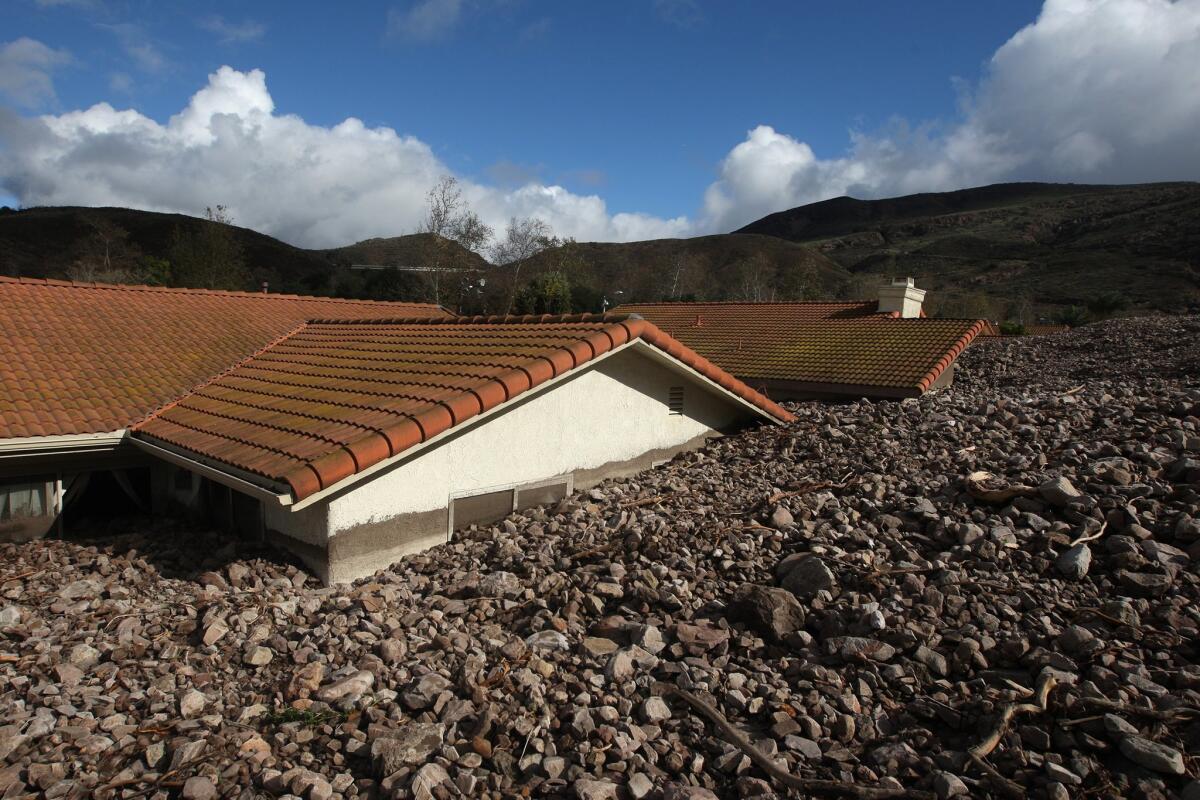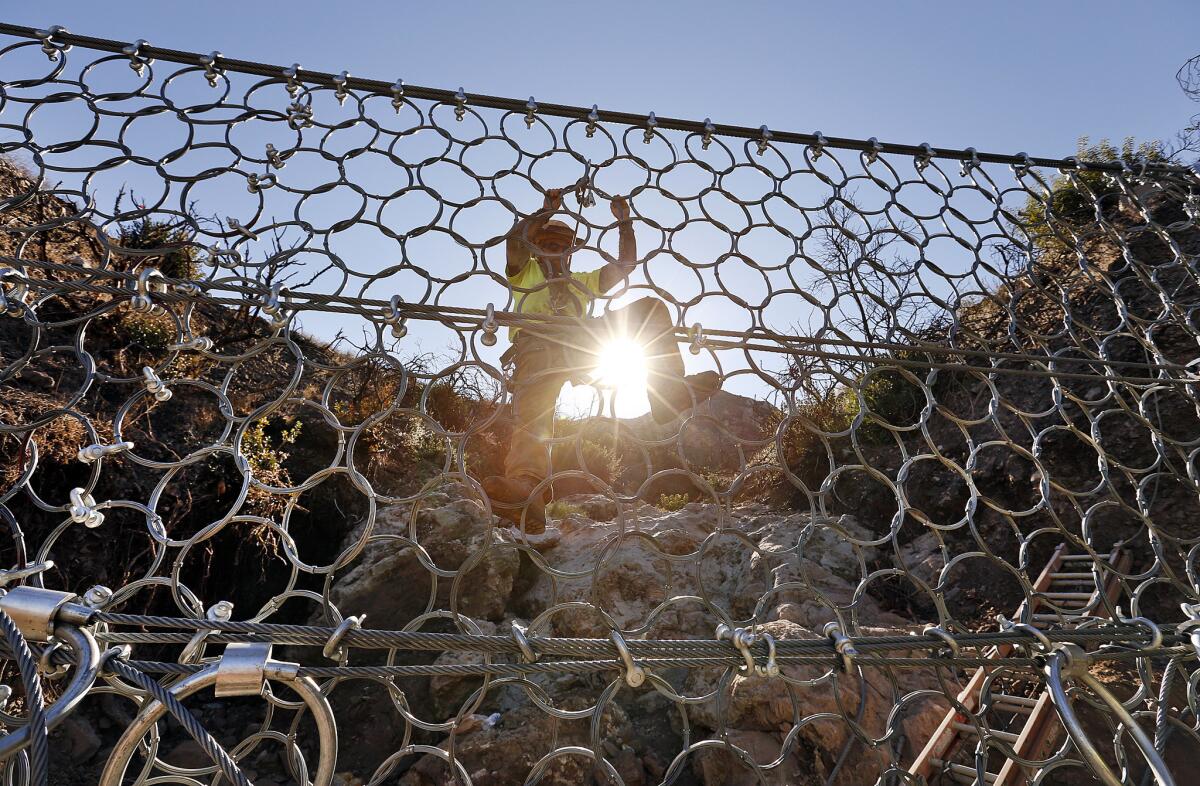Column: In Camarillo, a fight over who should pay to keep a mountain from crashing into homes again

Could anyone have predicted the Springs fire in May 2013? That it would tear across the Santa Monica Mountains, from Camarillo Springs to Malibu, incinerating everything in its path, searing the ground at temperatures as hot as 1,400 degrees?
Or that unusually heavy rains the next year would cause a horrendous cascade of mud and boulders off the now-slick slope, devastating a handful of the several hundred homes in Camarillo Springs, a modest planned community nestled at the base of Conejo Mountain?
Well, yes and no. The Santa Monica mountains, after all, are prone to wildfires. Wildfires lead to mudslides. Woe to houses that get in the way. But after the rains have gone and the debris is carted away, who is responsible for making sure the homes stay safe against future deluges?
That’s the issue swirling around Camarillo these days, as the residents of Camarillo Springs, represented by several homeowners associations, spar with city officials over who should maintain a new, $2-million system of debris barriers — giant metal nets strung across the bottom of deep gullies to catch rivers of mud and stones unleashed by winter storms.

The city says the residents who benefit from the protection, and the private individuals who own the mountain, should create and fund a maintenance plan. If they don’t, the city says, it will refuse to grant building permits for five red-tagged homes that have yet to be rebuilt. Nor will it spend the money it already has allocated to clean out the debris barriers, something that probably should be done before this year’s rainy season.
But the homeowners, plus the people who own the mountain (construction company owner Tom Staben, and the Longos, a group of relatives related to the founder of Camarillo), say they can’t afford to create a long-term plan. In any case, they say, they came up with their own, less-expensive plan last year. The Camarillo City Council unceremoniously rejected it, opting instead to put up its own system.
“The crux of the problem is there really is no money available to allow Tom Staben, or the Longos or the HOA to make the type of financial commitment that would be necessary to maintain these structures that were designed and built by the city of Camarillo on their own initiative,” said attorney Andrew Covner, who represents the Longos. “Yes, I commend them for taking the initiative, but it was kind of a panic thing: We’ve got to get this built. We’ll figure out maintenance later.”
Camarillo, which does not seem inclined to bend, is nevertheless taking up the issue at its next City Council meeting, on Sept. 28.

“At what point do you say enough?” asked Camarillo City Atty. Brian Pierik. “Suppose the city went out and did the cleaning, then what happens next year? We are looking to the long term. The affected parties — the people that own the land — should take responsibility.”
So now you’ve got a bunch of nervous retirees, living in modest homes, worrying about what will happen when the rain starts, and a city refusing to spend money it already has set aside to empty partly full barriers.
“The crunch right now is that we are working against time,” said Leonard Siegel, attorney for the Springs Homeowners Assn., who is adamant that his clients bear no responsibility for maintaining the city-built system. “Those debris basins have filled up, and they need to be emptied, and right now, nobody’s doing it. The city, having undertaken the construction in the first place, they’ve bought it. Or have the Longos take care of it.”
But Covner denied that his clients have any responsibility. Even if the slides originate on their land, they have made no improvements to the property, he said. “The law says if you don’t alter the natural condition of the land, you are not going to be responsible for what happens.”
In any case, he said, his clients are willing to try to work out a plan.
“I think the homeowners should take the lead, because they are the ones in harms’ way,” he said. “The problem is, there are maybe 30 or 40 homeowners that even have to worry about it and 500 others that could care less. It’s a touchy situation. There is no deep pocket here except for the city of Camarillo.”

::
There was a pretty good turnout Monday at the bimonthly meeting of the Springs Homeowners Assn. About 75 people showed up for a wide-ranging discussion that included whether the pool could be heated an extra couple of degrees (no) and a plea for folks to pick up their trash in the RV storage area. There was some banter about why the men’s bathrooms in the common areas are so grungy.
But the tone turned serious when the maintenance agreement was raised, and the conditions the city has put on the cleanup.
“The first thing that comes to mind is, let’s sue them,” said Springs HOA President Pete Faxon. “But our attorney has advised us the best way to resolve this is politically. We can write lots of letters to the editor, and use social media. We can take our problem viral. Tell people senior citizens are under attack by the city of Camarillo, that the city motto is ‘The people are the city,’ but that does not seem to apply to us.”
One woman suggested withholding property taxes but was reminded they are collected by the county. Another suggested hiring a media consultant. Ron Kester, whose home was destroyed in 2014 by a river of mud and rocks, suggested contacting a legal group that represents homeowners in disputes with governments.
After a lively half-hour, the meeting was adjourned. Nothing of consequence had been decided.
The bright spot in all this, if there is one, is that the mountain is starting to green up again. This is nature’s own hedge against another rock slide. More vegetation means less erosion. Thankfully, it doesn’t cost a thing.
Twitter: @AbcarianLAT
MORE FROM ABCARIAN
A Hollywood drug prevention counselor bemoans the coming legalization of cannabis
Marijuana: A potent disruptor for young users, whose brains are still developing
UPDATES:
1:55 p.m.: This article was updated with information about the city’s next meeting, which will discuss the issue.
This article was originally published at noon.



